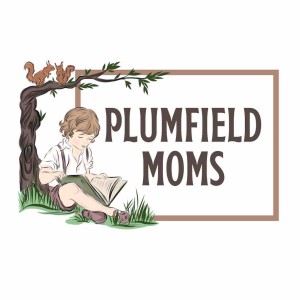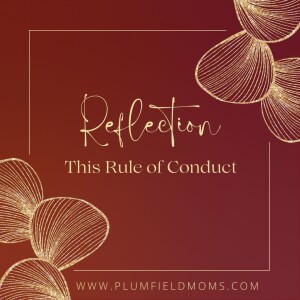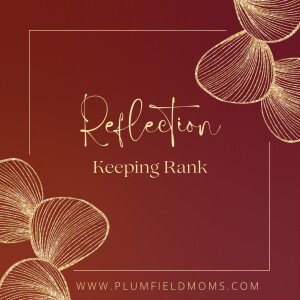Plumfield Moms
We are sisters in Christ who became friends over a shared love of Truth, Goodness, and Beauty, found especially in good and great books. Our primary vocation is that of marriage and motherhood, but we feel a secondary call, as educators and homeschool moms, to walk with families who are seeking to help form souls who are capable of responding to the vocation God has called them to. Our objective is to form our children and grandchildren to the best of our ability, and in so doing share what has been meaningful to us with others that it may encourage them and lighten their burden. As homeschoolers, classical educators and Christians, we have a passion for the ancient Greek paideia and the loving education of Louisa May Alcott‘s Plumfield (from her novel Little Men).
Episodes

Saturday Apr 12, 2025
Saturday Apr 12, 2025
"When was the last time you allowed yourself to be astonished to the limit by Jesus—by his teaching, by his works, by the wonders of your life? I use the word allow intentionally, because I think some of us are so jaded that we need to consciously loosen the tight hold we have on our sophistication and be amazed sometimes."

Monday Apr 07, 2025
Monday Apr 07, 2025
"If all history books were written in Graham’s style, no child would ever say, “I hate history.” With lyrical descriptions of time and place, she quickly drops the reader into her subject’s setting. The fear and despair of the opening scene are palpable. Graham doesn’t relate facts, she tells a story of real people with real feelings and motivations.
Graham doesn’t make Douglass a saint, but she takes us through his lifetime of dedication to the cause of freedom, not just for slaves but for anyone fighting oppression. We see what he suffered, what he gained, and what he lost."

Saturday Apr 05, 2025
Saturday Apr 05, 2025
Restore, keep watch, bear, test, share, do not grow weary of doing good, do good to all. “As for all who walk by this rule, peace and mercy be upon them, and upon the Israel of God” (Gal. 6:16).

Monday Mar 31, 2025
Monday Mar 31, 2025
Dan Morgan survived many amazing exploits, and the action in this story is exciting and almost non-stop. But the story doesn’t read like an adrenaline-soaked superhero tale. Dan was a real man who learned how to work hard, and who was dedicated to honing his craft and serving his country. He had astounding success, but also suffered losses and severe injury. He served valiantly throughout the Revolutionary War, and later was sent to Congress from Virginia.
Tucker managed to write this story using language accessible to the youngest independent readers while also keeping it interesting and compelling for parents and grandparents.

Saturday Mar 29, 2025
Saturday Mar 29, 2025
Peter doesn’t want us to be passively aware of danger. He wants us to actively resist. All of his instructions involve some exertion on our part. “Make every effort to supplement your faith” by adding virtue on virtue. “Be all the more diligent,” “practice these qualities,” “take care,” and “pay attention.” Paying attention isn’t simply a matter of sitting up and looking around. The Greek word is a nautical term that means to keep a ship on a course toward a specific place. Stay the course!

Wednesday Mar 26, 2025
Wednesday Mar 26, 2025
📚 Our Librarian Life – March 2025 Episode 🎙️
Join us for another exciting episode of Our Librarian Life, where we explore the world of living books, private lending libraries, and the power of community in literature!
In This Episode:
Amanda Cleary Eastep's Tree Street Kids
Amanda Cleary Eastep
Brodart Covers Sara Likes: Advantage I
Purple House Press 25th Anniversary Sale
Purple House Press Kickstarter
Purple House Press, Biblioguides, Plumfield GiveAway
Living Books Press
History Shapers at Living Book Press
21st Century Packhorse Librarian Interview
Seize the Book Facebook Group
Sara's Bible Commentary
The League of Lending Librarians
Private Lending Library Directory
Tell us your story!
Biblioguides
Semicolon
Book Review Roundup
Mighty Networks
Shelf Notes
Picture Book Preschool
LibraryThing
TinyCat
🎧 Listen Now & Subscribe!
📌 Don’t forget to share this episode with your book-loving friends!

Monday Mar 24, 2025
Monday Mar 24, 2025
I feel betrayed by The Education of Mary: A Little Miss of Color: 1832 by Anne Rinaldi.
Another disappointing novel by this author who is so often recommended to teens.
I confess that I do not know very much about the real Prudence Crandall. What I do know is that she is celebrated as an abolitionist, a courageous advocate for Black Americans, ran a school for “Little Black Misses” that was destroyed by the people of Canterbury, and was named Connecticut's state heroine. And, if the history books are right, in 1886, the people of Canterbury, Connecticut who destroyed her school for Little Black Misses, and Mark Twain, petitioned the state to offer her a small pension as recompense for the damage to her school and legacy.
I was intrigued to learn more about Crandall, and I love historical fiction. I find Ann Rinaldi’s books to be very uneven, and I was hoping that since this one was so well grounded in true historical facts, perhaps we would get an inspiring story about those courageous young black women and their teacher. And, for the first three-quarters of the novel, that is exactly what we get. Until the novel takes a sharp turn that leaves the reader discouraged and appalled. The only good that I can say of the ending is that it made me do some looking into the true story just to understand what was real and what was artistic license. So far, I have found nothing to support Rinaldi’s bizarre twist.
"Were they all modest, retiring, submissive, uncomplaining, long-suffering, and sacrificing? I found that difficult to believe." - Author’s Note
In 1831, Quaker Prudence Crandall was mistress of a school for young ladies. In need of servant help, she hired a respectable young black lady named Mariah Davis who was engaged to Charles Harris. Charles’s father was a local agent for the abolitionist newspaper, The Liberator. Crandall educated Mariah and even allowed her to sit in on classes since she was an employee of the school. Charles’s sister Sarah approached Crandall asking if she too could attend the school, but as a student, not a servant.
Crandall consulted her Bible and ultimately decided to educate Sarah. But the townspeople of Canterbury objected strongly. Crandall went to Boston to meet with the editor of The Liberator and came home with the mission to withdraw the white students and replace all of them with black young ladies from good families. Sarah’s sister Mary also attended the school.
". . . some ten or twelve quiet, harmless little colored girls or young ladies, from the very best colored families in the Northern cities." Source
By all reports, the girls in the school were well-mannered and eager to be there. In the novel, however, a very different culture was brewing.
In The Education of Mary, Rinaldi inserted her own prejudices deeply into the historical narrative. She casts young Mary Harris as a mild and faithful young lady who is both servant and confidante to Crandall. She re-casts Sarah Harris as an abolitionist fomenter who wants to be a Joan of Arc martyr for the cause. In the last fourth of the book, the school is divided down the middle with some girls taking Crandall’s side and attempting to live peaceably within the laws, while the other side was made up of agitators looking to be whipped and tortured so they could be remembered for the cause.
And while the agitators are whipping themselves up into a frenzy, they plot and plan, and ultimately set the school on fire while blaming an innocent black man. All so they can draw as much attention to their cause as possible. When Crandall fails to keep the girls peaceful, Mary surrenders her loyalty to the schoolmistress and betrays her.
The ending is sour and sad and depressing – and not because the school fails. But because the relationships inside of it are ugly and marked with strange forms of racism.
Such an interesting and hopeful book that turned dark in all of the wrong ways. I hope that my review can serve as a cautionary warning.
Also, parents may wish to know about a brutal scene with Mary and her father. In the novel, Mr. Harris is a Haitian immigrant who was denied schooling and will do anything reasonable to see that his children get the best that he can procure for them. Mary has been sent out of school for a fight she had with Crandall, and while at home, she has important work to do for another abolitionist cause. Despite her father telling her specifically not to sneak out, she does so anyway. When she returns to the family farm, her father throws her to the ground in a rage of fury, strips her cloak from her, pins her shoulder to the ground under the heel of his boot and horse-whips her. Brutally. Many times. We are forced to hear her thoughts as he whips her back and thighs.

Saturday Mar 22, 2025
Saturday Mar 22, 2025
"The Author and Finisher of our faith prayed that we believers would be one as he and the Father are one. Marching shoulder to shoulder with my fellow soldiers while keeping my eyes fixed on Jesus, who leads the way, will not only enable me to keep rank, but will also encourage those behind me and to the sides to do the same when the fiery darts begin to fly."

Friday Mar 21, 2025
Friday Mar 21, 2025
Our Reading Life - February 2025
Sarah Kim’s References
The Wake by Paul Kingsnorth
Brideshead Revisited by Evelyn Waugh
The Death of Ivan Ilyich by Leo Tolstoy
Great Gusts: Winds of the World and the Science Behind Them by Melanie Crowder and Megan Benedict
Sara Masarik’s References
The Pig War by Emma Bland Smith
Claude by Emma Bland Smith
ElevenReader App
Lepunia: the Last Galloper by Kevin Ford
Code: PLUMFIELD for 10% off everything on the site!
Mistmantle Chronicles by Margi McAllister
The Golden Hawks of Genghis Khan by Rita Ritchie
Kensuke’s Kingdom by Michael Morpurgo
Diane’s References
Behold Your Queen by Gladys Malvern
Forgotten Books Series: Historical Fiction, Plumfield Moms podcast
The Bounces of Cynthiann’ by Evelyn Sibley Lampman
Live Not by Lies by Rod Dreher
Freckles and A Girl of the Limberlost by Gene Stratton-Porter
Tanya’s References
Mary Poppins by P. L. Travers
Mother Carey’s Chickens by Kate Douglas Wiggin
The Gardener of Alcatraz by Emma Bland Smith
Kensuke’s Kingdom by Michael Morpurgo
Kensuke’s Kingdom Plumfield Moms Guide
General References
Biblioguides
The Card Catalog
Semicolon
Book Review Roundup
Mighty Networks
Shelf Notes

Monday Mar 17, 2025
Monday Mar 17, 2025
About two years ago, Diane and I did a deep dive into the works of Gary D. Schmidt, marveling at his ability to truly excel across genres. From the middle-grade brilliance of The Wednesday Wars to the magical fairy tale Straw Into Gold, from thoughtful and lovely picture books like A Long Road on a Short Day to the haunting historical fiction of Lizzie Bright and the Buckminster Boy, Schmidt continually astonished us. Mara’s Stories moved me deeply, and Orbiting Jupiter—written for boys in prison—left us nearly speechless with its raw truth. Schmidt had us convinced that there was little he could not write.
So, I approached his science fiction novel, What Came From the Stars, with high hopes. Yet, despite my love for science fiction, I struggled to enjoy it or even finish it. About half way through, I set the book aside with some regret.
Last month, I saw What Came From the Stars on Hoopla and decided to give it another chance. I’m glad I did.
While I may never cherish What Came From the Stars as much as I do Okay for Now or The Labors of Hercules Beal, this time I found myself genuinely enjoying the novel. Perhaps it was familiarity with the story from my first attempt, or maybe I was just in the right mindset. Either way, the book’s layered storytelling and emotional depth resonated with me.
At its heart, What Came From the Stars is an honest exploration of grief, destiny, familial love, and sacrifice. Schmidt’s talent for portraying grief remains unmatched—each of his stories feels fresh, raw, and powerful.
This novel follows Tommy Pepper, a boy from Plymouth living in a creaky old house by the sea with his father and little sister. Together, they are grappling with the unexpected loss of Tommy’s mother. Their grief is compounded by an unscrupulous real estate developer pressuring them to sell their beloved home.
What made this story confusing to me the first time, but interesting this second time, is its dual narrative. One thread is firmly grounded in Tommy’s world, while the other unfolds in a fantastical realm embroiled in its own struggles. These two worlds collide when Tommy receives a birthday gift from his grandmother—a seemingly ordinary lunchbox with mysterious contents that alter his reality.
Schmidt weaves these threads together with skill, creating a story that is part science fiction, part fantasy, and wholly human. While it may not be my favorite of his works, What Came From the Stars is a testament to Schmidt’s range and his ability to delve into the depths of human emotion, even in the most unexpected genres.
If you’ve set this book aside before, consider giving it another try. You might find yourself drawn into its intricate web of loss, love, and hope, just as I was.








